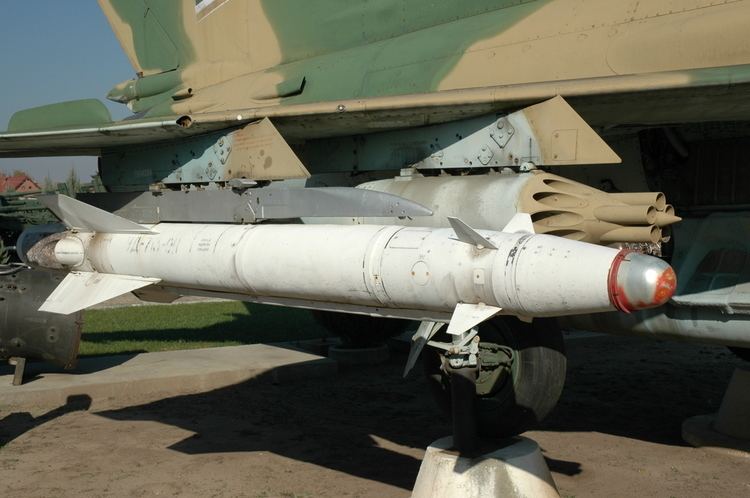In service 1975–present Designer Zvezda-Strela | ||
 | ||
Type tactical air-to-surface missileanti-radar missile (Kh-25MP) Wars see Operational history | ||
The Kh-25/Kh-25M (Russian: Х-25; NATO:AS-10 'Karen') is a family of Soviet lightweight air-to-ground missiles with a modular range of guidance systems and a range of 10 km. The anti-radar variant (Kh-25MP) is known to NATO as the AS-12 'Kegler' and has a range up to 40 km. Designed by Zvezda-Strela, the Kh-25 is derived from the laser-guided version of their Kh-23 Grom (AS-7 'Kerry'). It has now been succeeded by the Kh-38 family, but the Kh-25 remains in widespread use.
Contents
Development
Based on an air-to-air missile, the beam-riding Kh-66 had been the Soviet Union's first air-to-ground missile for tactical aircraft, entering service in 1968. However it proved difficult to use in practice as the launch aircraft had to dive towards the target. A version with radio-command guidance, the Kh-23, was first tested in 1968 but problems with the guidance system meant that it would not enter service for another five years. So in 1971 work began on a version with a semi-active laser seeker, which became the Kh-25. This was initially known in the West as the Kh-23L. State testing began on 24 November 1974, and the Kh-25 entered production in 1975.
Work began on an anti-radar missile derived from the Kh-66 in 1972, using a passive radar seeker and SUR-73 autopilot. The long-range Kh-31 anti-radar missile came out of the same project. The Kh-27 began state testing on a MiG-27 on 8 August 1975 but did not enter service until 2 September 1980. It was assigned the NATO reporting name AS-12 'Kegler' and in effect it replaced the much heavier Kh-28 (AS-9 'Kyle').
In 1973 Victor Bugaiskii was appointed head engineer of the bureau and he started work on combining the Kh-23M, Kh-25 and Kh-27 into a single modular system to reduce costs and improve tactical flexibility. This was completed by the end of 1978, resulting in the Kh-25MP (anti-radar), Kh-25ML (laser-guided) and Kh-25MR (radio-guided) family. NATO continued to refer to these as the AS-12 and AS-10 respectively, even though they could now be switched by a simple change of seeker head.
Design
The Kh-25 is very similar to the later version of the Kh-23, with cruciform canards and fins.
The Kh-25MP has two versions of its homing head, 1VP and 2VP, sensitive to different frequencies.
Combat history
The original Kh-25 entered service with the Soviet Air Force between 1973-5, equipping the Mikoyan-Gurevich MiG-23, MiG-27 and Sukhoi Su-17M. Since then it has been cleared for use on the MiG-21, MiG-29, Sukhoi Su-17/20/22 family, Sukhoi Su-24, Su-25 and Su-27. It can also be carried by attack helicopters such as the Kamov Ka-50.
The Kh-25MP can be fitted to the MiG-23/27, Su-17/22, Su-24 and Su-25.
Soviet war in Afghanistan
Starting in April 1986, during the second Battle of Zhawar, Kh-25MLs were used by Soviet Su-25 Frogfoots from the 378th OshAP (Independent Shturmovik Aviation Regiment) to attack Mujahideen cave entrances used as shelters and weapons storage facilities. Attacks were carried out from up to 4.5 nm (8 km).
Iraqi invasion of Kuwait
During the Iraqi invasion of Kuwait, on August 2, 1990 an Iraqi Air Force Sukhoi Su-22 from the No.109 Squadron (based at as-Shoibiyah AB) fired a single Kh-25MP anti-radar variant against a Kuwaiti MIM-23B I-HAWK SAM site at Bubiyan Island that had earlier downed another Su-22 from the same unit and a MiG-23BN from the 49th Squadron. This forced a radar shutdown on the HAWK. The HAWK battery (which was operated by some American contractors) was later captured by Iraqi special forces and found out to be in automatic mode of operation, after the contractors fled. Iraq also used its Kh-25s during its war with Iran.
Russia intervention in Syria
Russia's air strikes on US supported rebels in Syria, used the Su-24 jet with Kh-25 laser-guided missiles.
Variants
NATO refers to all of the Kh-25 family as AS-10 'Karen' apart from the anti-radar variants. An "M" designation stands for "Modulnaya" – modular (seeker head).
Training rounds have "U" designations, so, e.g., for the Kh-25ML there is:
